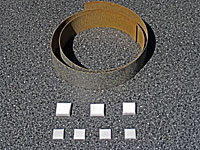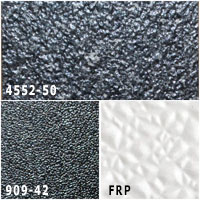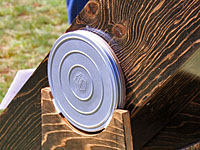

Dobsonian Bearing Materials
The key component of a Dobsonian Mount is its bearings - they should be "buttery smooth", moving without a startup 'jerk' and holding the telescope position when no pressure is applied. The key to achieving this ideal situation is to use the correct materials. In this section we will describe bearing materials, why certain ones are selected, and give you some pointers on where to obtain them.
Ebony Star & Teflon

Wilson Art brand Ebony Star style kitchen counter laminate (#4552-50) and Teflon pads are the widely agreed upon materials for Dobsonian bearings. Ebony Star is a slightly textured laminate, and the "bumpiness" seems to be an important element to get the correct feel in the finished scope. Teflon is extremely slippery and does not stick to other materials, pads of Teflon slide with just the "sticktion" over Ebony Star.
Years of Research: In the summer of 1980, Richard Berry in Telescope Making #8 published measurements of various combinations of bearing materials and end with "I would like to see others, better equipped for such work, carry out more complete experiments on friction between Teflon, Formica, and other materials suitable for use in Dobsonians". In TM #35 (Winter 1988) David Kreige (founder of Obsession Telescopes) reported superior results with a textured #7181 Beige Tweed Formica laminate. In in TM44 (Spring 1991) Kreige reported he had 'discovered' Wilsonart Ebony Star that he found worked even better. In October 2003 Sky & Telescope published an article by Martin Lewis he claimed that a Perfluoralkoxy fluorocarbon (a relative of Teflon) was a superior pad material. While this may be true, few, if any, scopes have been built using this material - Teflon and Ebony Star are still the standard.
Laminate Update

Since the above was written, Wilson Art has discontinued the 'pebbly' -50 finish that was used on their Ebony Star (#4552) pattern. The pattern or color is not important - it is the surface texture, known as the finish, that is. Note that the Ebony Star pattern is still available as a special order, but only in surface finishes that are not suitable for bearing use.
The most widely accepted replacement is now from competitor Formica: Their -42 finish (named 'Crystal') is a finer scale textured pattern that is giving good results and many users say they can't tell the difference from the Ebony Star in side-by-side comparisons. Again, it is the finish that is critical, and this finish is available in many patterns, including all Formica solid color patterns. Black (#909) is the most popular choice, so you want to shop for Formica 909-42, or in words 'Black Crystal Finish'.
The other good choice is White FRP Wall Board. This has a surface texture more similar to Ebony Star, but at a larger scale. At 0.090 inches thick, it is about twice as thick as a countertop laminate and somewhat harder to bend. Given the larger texture scale and greater thickness, I would be more inclined to use this on bigger scopes (12 inches and up) although we have built a couple of 6- and 8-inch scopes with it at Stellafane successfully. It sold as 4×8 foot sheets.
Both of the above products are currently widely available in home centers and larger hardware stores. There are other textured laminate patterns available from both Formica and Wilson Art, but these patterns are more random with some voids that might lead to non-uniform performance of the bearings. At this time, Formica 909-42 is your best bet - and feel free to choose another fashionable color if you want your scope to stand out from the crowd.
Mechanical Issues
While using appropriate materials is important, their contact size, pad thickness, and pad placement can have a big impact on bearing performance. This is especially true for large Dobsonians that can weigh in at 100 pounds and above. For the small Dobsonians we are building, the telescope weight is light enough so that these issues are not as critical. We will discuss altitude bearing pad placement to control friction the rocker box section, but otherwise assume the minimum sized pads we specify will handle our smaller scopes just fine.
Dobsonian bearings work best when the have a high linear velocity for even small movements of the telescope; this mean large diameter bearings are called for. Azimuth bearings usually have adequate size because mount stability requires it; often altitude bearings are undersized because of lack of knowledge of this issue or because plumbing parts are used for them for convenience. We will specify adequately large bearings on both axis.
Alternative Materials
We urge you to use the standard materials - they work well and are available and not very expensive. But if for some reason you need or want to use something else, here are some suggestions that might work for small Dobsonians.

If you can't obtain a textured laminate, a smooth laminate might work acceptably. When a new kitchen countertop is installed, a large cut out for the sink must be made. These kitchen sink cutouts - laminate covered composite wood - could be used for the bottom of the rocker box. Smooth metal could also be used in place of laminate - this is done with cast altitude bearing or 'film can' altitude bearings (note that some builders cover these metal parts with laminate).
HDPE (High Density Polyethylene) has almost the same slipperiness as Teflon, and you could try subsisting if necessary. Also, many home centers and hardware stores now carry a line of Teflon coated furniture glides that might work - our one concern with these is they seem to have a soft inside below the Teflon coating, and might not perform as well as solid Teflon pads.
Obtaining Bearing Parts
Full sheets of laminate are orderable at any place that carries laminates - but you probably don't need a full sheet. Similarly large sheets of Teflon are available at plastics distributors, but again you probably only need a few square inches, and they will only sell you many square feet.
Several amateur astronomy vendors sell these materials in quantities more appropriate for amateur telescope makers. Since the list of vendors is changing constantly, we are not going to list them here - please see our Links Page under Vendors - Mounts, Kits & Tripods.
You should be able to find vendors who will sell you laminate sheet or rings (for the bottom of your rocker box - azimuth bearing), laminate strips (for your altitude bearings) and Teflon in small strips, which you can cut yourself, or in pads, some drilled and countersunk, for both bearings. Please see the appropriate page in our Mount section to learn what sizes and quantities you will need.
If you shop around on the vendor links, you may also find cast metal, routed wood or plastic altitude bearings. While we won't use these, you might decide to use such parts on this project or in the future.
Cutting Laminate
The best way to 'cut' laminate is by scoring deeply with a box cutter on the finished side and then snapping it along the score upwards towards the score. This will leave a ragged cut, so make your piece a little bigger to account for this and then sand the edge smooth once it is glued in place.
Previous: Sawing, Shaping, Drilling & Sanding
Back to the Build a Dobsonian Master Index